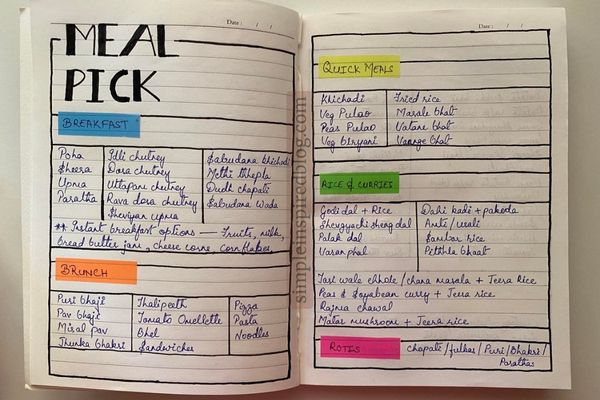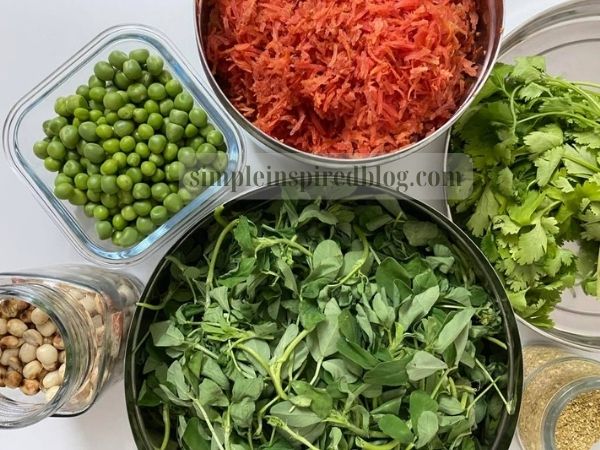Well, before you even start to wonder if meal planning is for you, let me tell you there’s something for everyone.
Does the “What’s for dinner” question stress you out every single day?
Do you run out of ingredients while cooking your favorite meal? Whereupon, do you need to rush to the grocery store to buy an ingredient or two?
Do you grab a take-out because you don’t want to deal with the lengthy cooking procedures?
Here’s a quick solution: Meal Planning
Meal Planning might sound like extra work but it’s going to make your life easier.
I’m sure, you’ve heard about many different meal-planning techniques. That’s because meal planning is no one size fits all approach. What works for you might not meet someone else’s requirements.
I cannot stress enough the fact that a little planning and prep up goes a long way in accomplishing things. Meal planning is no different.

Cooking is an inevitable part. Hence it’s always better to simplify things for yourself if you really want to eat at home, most days a week. When you have a menu plan, you’re motivated to purchase the ingredients required for the selected recipes. With little prep, you’re likely to cook at home.
I used to grocery shop recklessly. And buy a lot of packaged food along with healthy stockpiles.
Due to a lack of planning, I couldn’t decide what to cook until dinner hour and order food from the restaurant at the end.

What is Meal Planning?
A meal plan is a list of weeks worth of meals.
It usually includes breakfast and dinner recipes, that you pre-plan to make in the forthcoming week. The chart works like a roadmap.
On a weekend/weekday, you sit down for 10-15 minutes to plan meals and make a grocery list. And follow that plan, throughout the week without having to spend your time and energy deciding what to cook for dinner, every single day.
This will ensure harmonious daily routines.
Sometimes we may think having a well-stocked pantry will allow us to skip meal planning. It doesn’t work for me. It still takes up energy to determine what to cook. It’s like “a wardrobe full of clothes but nothing to wear” thing for me. This technique might work if you plan and prep up at least the night before.
Related: 6 Reasons You Should Start Cooking From Scratch Today
Before we start with our three-step meal planning method, if you’re a beginner, you have an additional step to do. Which I suggest you do in your leisurely time and not while planning your meals.
1. Jot down all the meals that your family enjoys. (you can include breakfast recipes along with main meals)

2. From these, pick the meals that everyone likes in common, in your family.
3. Now, sort some quick and easy one-pot meal recipes out of the list. They can be your go-to recipes when you’re short on time. One-pot meals can come in handy when you’ve had a long day, not feeling well, or having a lazy day.
4. This list of recipes is your dinner and breakfast options which you‘ll need at the time of weekly meal planning for reference. You can get it printed or write it in a planner.
Meal Planning in Three Easy Steps:
1. Menu plan:
Note down the meals for the week.
This is the time to decide:
how many meals do you want to cook in a week?
Plan leftover days, full meals, quick meals, crockpot meals, and eat-outs.
For example: if you want to cook 6 days a week. Aim for 3 full meals, 2 quick meals, 1 leftover day, and a day off for eat-out. For busier days, slow-cooker recipes could be very helpful.
This kind of balance will help keep things interesting.
If you have a bigger family try to incorporate everyone’s favorite meal into the week. Ask your family to suggest what they would like to have for the week?
Take into account, beans, veggies, sprouts, grains, leafy veggies, fish, chicken, eggs, and meats to add variety for a healthy balanced diet.
You can plan your breakfast as well to start your day on a healthy note.
2. Grocery list and shopping:
Make a list of the ingredients you need for the whole week’s meal plan.
I recommend using the Note App to quickly write down the menu plan and grocery list.
Using an app helps avoid dealing with papers, planners, sticky notes, markers, etc., It makes editing easier and saves time from rewriting the lists. Plus, you can head out shopping conveniently with your phone.
Group ingredients together like dairy stuff, veggies, spices, meats, etc., to waste no time at the grocery store.
To save money, I urge you to take an inventory before leaving for grocery shopping. Remove the items that you already have. Make it a point to stick to the list.
If you’re someone who likes to ‘shop on sale’ meaning shop things that are on sale in that particular week. Then, you will have to grocery shop first and make a meal plan around the items you have purchased.
3. Meal prep:
Prepping up your meals is helping your future self. You’ll be relieved and thankful you did.
It’s like getting a chunk of work done earlier. Which is gonna make cooking a breeze!

Being realistic with prepping up is important though.
Cutting the veggies a week before and storing them in a plastic container is unhealthy.
I suggest doing the chopping, kneading, and marinating work the night before. Things like organizing the pantry and refrigerator for easy access, washing and storing fruits and veggies, dry roasting, peeling green peas, garlic, carrots, and bunching ingredients together can be done a week before.
Final Words:
Planning meals in advance make grocery shopping and cooking at home easier. It is healthy and stress-relieving. Meal planning saves a lot of time, energy, and money.
Try to keep the meals simple and healthy. If you want to try out a new recipe, schedule it for a relaxing day. Always make sure to check your pantry and list the only items that you need to prevent wastage.
Over to you. I would love to learn more meal-planning tips from you. Please leave your tips and tricks in the comment section below. Thank you so much for reading. Happy Meal Planning!
Pin for later


Leave a Reply
You must be logged in to post a comment.